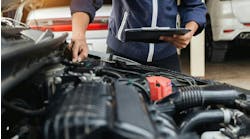Learning the care and service of drum brakes.
In this issue of Motor Age, our contributors have shared information on the intricacies of wheel speed sensors and the proper care and servicing of rear differentials and axles. My contribution this month is a discussion on the care and feeding of conventional drum brakes.
While not strictly meeting the criteria for our underhood segment, I felt it appropriate since much of what has already been shared is common to the rear half of the vehicle.
Stealing a reference from my good friend Richard McCuistian's story in this same issue, early braking systems consisted of nothing more formal than a lever that was used to apply a wooden pad against the iron-banded wooden wheel. The first drum brakes were external designs, first appearing around 1899. The man most credited for the invention of the modern automotive drum brake was a Frenchman by the name of Louis Renault, though there are records of similar designs in use before his debut in 1902.
These external designs left much to be desired, as they were exposed to the elements and required frequent servicing. It wasn't long before the braking components were moved to the inside of the drum.In 1918, Malcolm Loughhead (later to become one of the founders of the Lockheed Aircraft Company) developed a four-wheel hydraulically operated system that made its production appearance on the Duesenberg. The hydraulics, of course, reduced braking effort considerably and the concept was soon adapted by other carmakers.
How Today's Systems Work
While it may, at first, look complicated when you remove the drum and peer inside, drum brake operation is relatively simple and quite interesting. There are variations on the theme, but the essentials are common: Two brake linings (or shoes) pivot at one end and are forced outward at the other by a hydraulic piston (wheel cylinder), bringing the friction material into contact with the inner circumference of the brake drum.
Once in contact, physics takes over and the energy of motion (the moving drum) is converted to heat energy and dissipated, slowing the car to a stop. Typically, springs and/or clips are used to keep the shoes in place when not in play. Then, you might ask, what are those heavier springs I'm always fighting with for?Interesting you should ask. What's really neat is the "self-energizing" characteristic of most drum brake designs. As the linings come into contact with the inner diameter of the brake drum, the rotating force of the drum creates a wedge-effect between the shoes and the drum. Without the heavy springs as a means of return they would never let go until the drum stopped turning altogether, and that would make braking an either/or proposition. The car would either be moving or stopping — there would be no in between!
Keeping It Tight
In addition to the parts needed to brake and release are parts used to keep things in adjustment. Unlike disc brakes that self-adjust to maintain the clearance between the pads and rotor, wear of the brake lining in a drum brake system requires manual adjustment in order to maintain proper clearance. A few giveaways to excessive clearance are excessive brake pedal free play and excessive parking brake lever movement (rule of thumb on a parking brake hand lever is four to six clicks). Out of adjustment drum brakes put even more load on the front brakes and reduce overall stopping distances. So how does the system maintain adjustment?I mentioned manual adjustment, but I should be more correct and refer to it as a mechanical adjustment. The adjusting mechanism consists of a threaded assembly with a star adjustment wheel on one end. An adjusting plate is attached to one shoe's metal backing and pivots on this mount. One end of the plate rides on the star wheel, and the other either rides against a bar assembly located between the two shoes or to a cable that is routed to the stationary pivot post. When the brakes are applied and the drum is turning in reverse, the adjusting plate pivots with the motion. If the play between the shoes and the drum is more than it should be, the plate will move far enough to turn the star wheel one notch tighter, increasing its overall length and taking up the slack that previously existed.
Some adjustment systems rely on the parking brake to actuate the adjusting mechanism. Often, this also is the OE preferred method for making any final adjustments after performing a reline. In real life, however, neither method is used often enough to keep the rear brake linings where they should be during normal driving. Adjusting them for your customer should be an included part of any maintenance service you perform and certainly corrected whenever any brake-related work is done.
In addition, encourage your customer to make use of his or her parking brake a routine habit. Not only will this help maintain his braking performance (on those cars using this adjustment method), but many techs believe it also will reduce the unnecessary wear and tear on the overall driveline by eliminating the rocking encountered as the vehicle's weight settles without the brake applied.In addition to the adjusting mechanism are the components needed to operate the parking brake system. Older cable-actuated systems were straightforward designs using a pivot arm to transmit cable force to the spacing bar, spreading the shoes into contact with the drum. More and more, electric parking brake systems are being used and you can read more about them by referring to the September 2011 issue (which you can access easily online at MotorAge.com).
Service and Repair: Drum Removal
Any brake repair should begin with a conversation with the customer. Are they bringing the vehicle in for a specific complaint or just to have a routine check of the brakes done? Next, take the car for a drive and try to duplicate any reported complaint. Does the pedal feel good and tight? Any pull or pulsation noted while stopping?With the car in the air and the wheels removed, remove the drums to reveal the linings. What, the drums won't come off? It happens more often than not, and usually is caused by rust build-up between the drum and the hub and/or the little lip that forms on the inner circumference of the drum (where the brake linings are not in contact and not wearing the drum surface). You can overcome the first by spraying a little penetrating oil and providing a little encouragement with a dead blow hammer applied with authority. The second is a bit more involved.
It might be necessary to back off the mechanical adjuster by accessing it through the adjustment slot common on the backing plate (the plate to which the shoes and other components are attached). You'll have to use a screwdriver to push the adjusting plate away from the star wheel and then rotate the star wheel in its opposite direction to allow the brake shoes to retract further away from the drum.Before you actually remove the drums, grab a dust mask and place it over your nose and mouth. In the old days, brake linings were made with asbestos and we all know now how bad that is. You might not be dealing with asbestos, but it is still a good idea to avoid breathing in stuff you don't have to. This is your career, and little things do add up over time. Safety first!
With the drum off, inspect for signs of leakage from the hydraulic wheel cylinder. Some seepage or staining is not abnormal due to the nature of the seal design but if fluid has saturated the dust around the cylinder boots (or worse), then recommend rebuilding the units (yes, you can do that) or replacing them.The same safety rules apply when cleaning the assembly. There will be dust build-up in the drum and over all of the components. Don't blow it off with shop air! Instead, use a water-based cleaner and cleaning stand to wash it all down. With the drum clean and dry, inspect it for obvious signs of damage and then use an inside micrometer or brake gauge to verify the inside diameter is still within serviceable limits.
Service and Repair: Reline
When performing a reline on a drum brake system, it is a good idea to leave one side intact while working on the other. This way you will have a reference in case you forget where the springs go.
Techniques vary from tech to tech, but I personally like to release the return spring(s) closest to the stationary pivot (usually opposite of the wheel cylinder) and disconnect the parking brake cable, before removing the locating springs or clips. Often, this is enough to allow you to spread the shoes slightly and lift them away from the backing plate as an assembly. Continue your disassembly on the bench.
Wear eye protection when removing and installing the return springs and be sure to use the right tools for the job to avoid shooting springs at the tech in the next bay. Using the right tools also minimizes your effort and avoids potential damage to the springs that could result in their future failure. The use of diagonal cutters or pliers to pull the springs into position is strictly verboten.
With everything now removed, carefully inspect the backing plate where the linings ride, usually three spots per lining. Indentations here can cause the linings to stick in place and impact brake operation. Replace the backing plate if damaged. If not, apply a very small layer of anti-seize or high temperature lubricant to the contact pads to make it easy for the linings to return to their neutral position and to minimize noise. Apply a touch of lube to the shoe pivot(s) and to the tips of the wheel cylinder pistons while you're at it.
Now it's no secret that oil and grease on the friction material will reduce their effectiveness. To avoid getting any on the linings, take some masking tape and cover them before you reassemble. Be sure to properly identify the leading edge and install the shoes in the correct orientation. Assemble using new hardware and replace the return springs, using the proper tools to install them. You can gain a little extra leverage by using a pair of ChannelLock welding pliers to hold the shoe(s) in place.
Now you're about ready to reinstall the drums. You've completed your resurfacing, right? And just as you would a rotor, you've taken the time to clean the drums of any remaining metallic dust by cleaning them in a bath of hot, soapy water.
Use a brake gauge set to the new ID of the drum as a quick go/no go reference and make your preliminary adjustments to the brake adjuster. Then follow the specific instructions for final adjustment suggested by the OE you read up on in your service information system.
Some Asian models use the parking brake lever as the final adjustment method, while others have an access plug in the backing plate that allows fine tuning with the drum installed. On these, lightly install a couple of the lug nuts to keep the drum fully seated against the hub. Rotate the drum as you make your adjustment to keep the shoes centered.
With the wheels back on, the final step in performing a drum brake service is the same as any other repair. Verify that all is working as it should before returning the car to your customer.
Yes, I know, this hasn't been a high tech feature. It is, however, a task that is performed by techs all over this country hundreds of times a day. Like all we try to do here at Motor Age, if you picked up one tip, one bit of info, that helps you do that job a little easier, well, then it's all good, isn't it?


